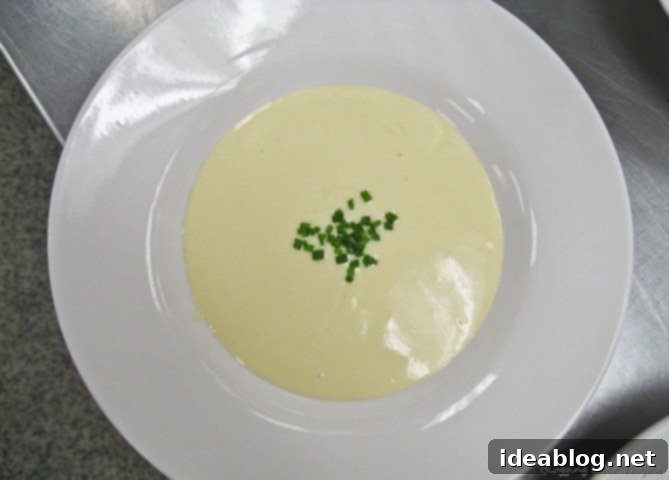Mastering Culinary Arts: A Day of Classic French Dishes and Essential Butchery Skills
The culinary journey is as thrilling as it is demanding, especially with a practical exam looming large this Thursday. The anticipation, mixed with a growing sense of anxiety, underscores the intensity of professional chef training. Each day in the kitchen is a rigorous balance of reviewing fundamental techniques and embracing the challenge of new, complex dishes. This post offers a glimpse into one such pivotal day, where classic French cuisine and essential butchery skills took center stage, all while keeping a watchful eye on the upcoming assessment.
The Art of Cold Soup: Crafting a Perfect Vichyssoise
Today’s culinary agenda kicked off with a delightful exploration of Vichyssoise. This dish, often perceived as sophisticated due to its French name, is at its heart a potato and leek soup, traditionally served cold. While we had previously mastered its warm counterpart – a comforting hot potato and leek soup during Week 2 – the cold version presents its own unique set of challenges and considerations. Notably, both the hot and cold variations are essential components of our upcoming practical exam, alongside a range of other demanding dishes, making precision paramount.
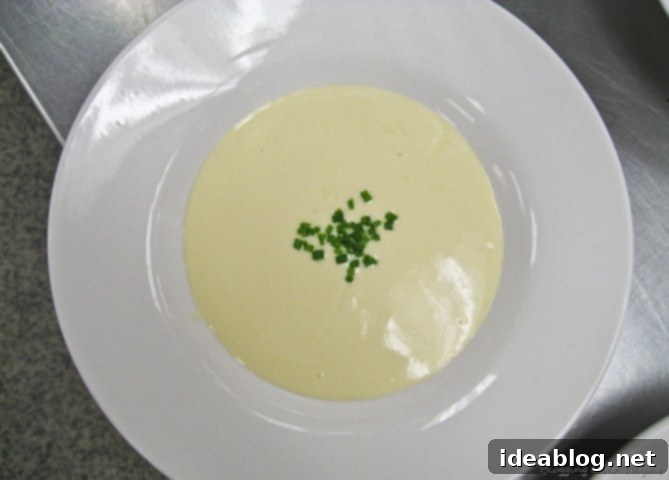
Despite its apparent simplicity, preparing an exquisite Vichyssoise requires meticulous attention to detail. The core challenge lies in achieving the perfect balance of potato and leek, and crucially, avoiding the overworking of the potato’s starch. Mishandle these elements, and you risk transforming a potentially smooth, creamy soup into an unappetizing consistency reminiscent of wallpaper paste. The goal is a velvety texture, rich in the subtle, earthy flavors of potato and leek, without any gumminess.
The process involves carefully cooking the vegetables until tender, then pureeing them to an incredibly smooth consistency, followed by fine straining to remove any fibrous bits. This foundational step ensures a refined texture. Once the soup base is perfected, cream is stirred in, and the mixture is allowed to chill thoroughly in the refrigerator. An important nuance of cold dishes is the way cooling significantly diminishes the intensity of flavors. To counteract this, it’s common practice to re-season the Vichyssoise with additional cream and salt just before serving, adjusting for the temperature change and ensuring the flavors truly sing. This particular soup was exceptionally good, offering a rich and satisfying culinary experience, albeit a very decadent one.
Continuing “Duck Week”: Braised Leg with Savory Sides
Our culinary curriculum continued its immersive focus on duck this week, culminating in a magnificent braised duck leg served alongside a robust cabbage mixture and delicate pommes darphin. These crispy potato pancakes, made from finely julienned potatoes, are another critical dish slated for our practical exam, highlighting the importance of precise knife work and controlled cooking.
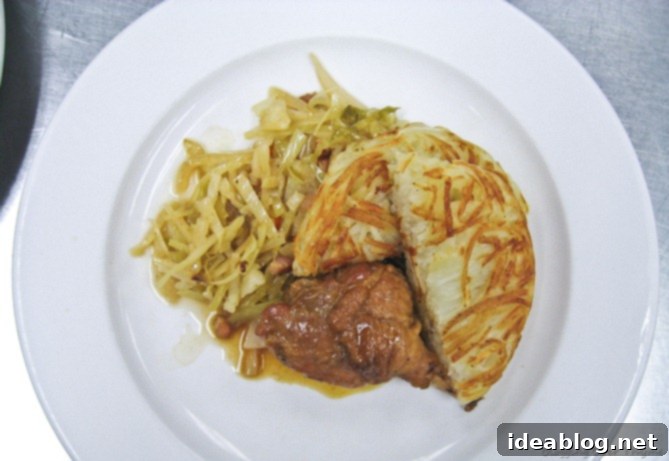
The braised duck leg followed a preparation method familiar from our previous stewing exercises in Phase I, yet each iteration brings new layers of understanding. The process began with expertly searing the duck meat to achieve a deep, golden-brown crust – a crucial step for developing profound flavor through the Maillard reaction. Following this, the pan was deglazed with a classic mirepoix (an aromatic blend of diced carrots, celery, and onions), white wine, and a selection of complementary flavors, before finally incorporating rich veal stock. This carefully crafted liquid forms the foundation of our braising sauce. The seared duck legs were then returned to this aromatic liquid and slowly cooked in the oven for approximately two hours. This prolonged, gentle cooking process is essential for breaking down the connective tissues in the duck legs, rendering the meat exceptionally tender, succulent, and infused with the complex flavors of the braising liquid.
Accompanying the braised duck was a wonderfully balanced cabbage mixture. This vibrant side dish was composed of crispy bacon, sweet onions, finely shredded cabbage, carrots, and tart apples. A crucial addition was a splash of apple cider vinegar, which provided a bright, acidic counterpoint to the richness of the duck and bacon. I was pleasantly surprised by how much I enjoyed this combination; its sweet, savory, and tangy notes complemented the duck exceptionally well, elevating the entire dish beyond expectations. It served as a perfect example of how thoughtful flavor pairings can transform a meal.
The Delicate Dance of a Soufflé: Grand Marnier Perfection
For our dessert, we embarked on the challenging yet rewarding journey of creating a Grand Marnier Soufflé. This marked our inaugural attempt at making soufflé, a quintessential French dessert renowned for its ethereal lightness and dramatic rise. Soufflé production demands not only precision in technique but also impeccable timing, as it must be baked and served immediately to preserve its characteristic volume and delicate texture.
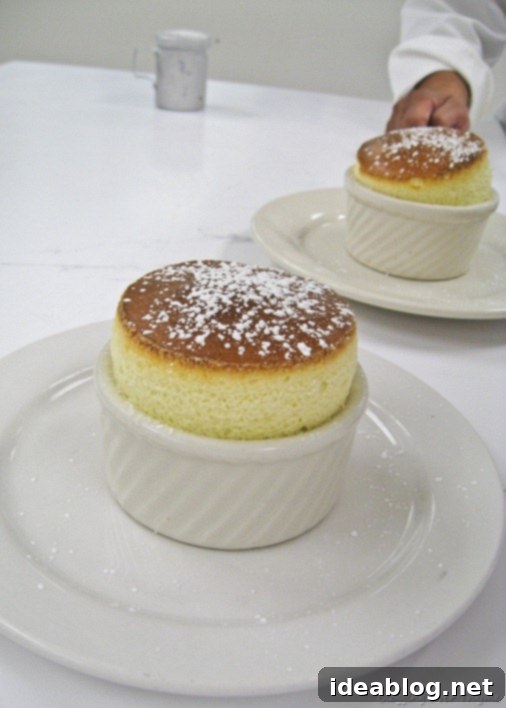
The basic architecture of a soufflé involves several critical steps. It starts with the creation of a rich béchamel sauce, which forms the stable base. To this, sugar and egg yolks are carefully whisked in, creating a flavorful, smooth custard. The true magic, however, happens just before baking, when meticulously whipped egg whites are delicately folded into the base. This folding technique is paramount; it’s what incorporates air and provides the lift that gives the soufflé its iconic puffy structure. Any mishandling here can lead to a deflated or dense result.
While our attempts were commendable for a first try, I must concede that the soufflé pictured above – a masterpiece crafted by the esteemed Chef Somchet – undeniably surpassed ours in perfection. His creation stood tall, flawlessly browned, and texturally impeccable. This experience, however, merely fuels the desire for mastery. We anticipate many more opportunities to practice various soufflé preparations in the future, encompassing savory versions like spinach and cheese, as well as other sweet variations such as chocolate. With dedication and continued guidance, we are confident in our ability to hone this intricate technique to perfection, transforming initial challenges into consistent success.
To accompany our soufflé, we served a selection of almond, pistachio, and cranberry biscotti. While I typically don’t count myself among the biggest fans of biscotti or any seriously crispy cookie for that matter, these particular ones proved to be an exception. The delightful combination of nutty almonds, vibrant pistachios, and tart cranberries, coupled with a perfectly executed crunch, made them some of the finest biscotti I’ve ever encountered. Their texture and flavor profile provided a pleasing contrast to the light, airy soufflé.
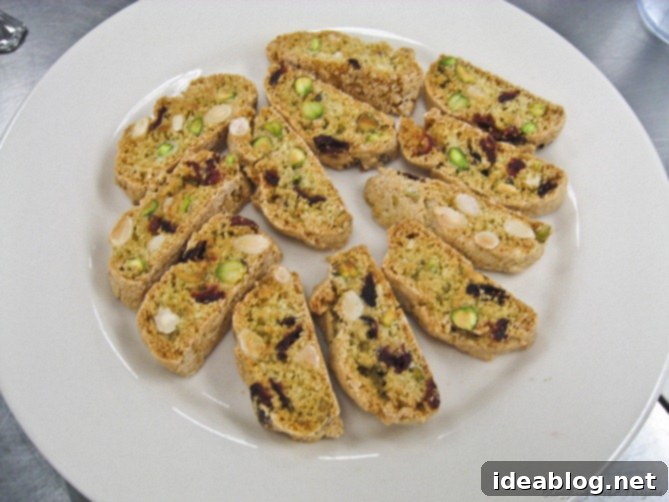
Anatomy of Excellence: A Deep Dive into Pork Butchery
As is customary for Tuesdays in our program, the day concluded with another insightful meat lecture, this time focusing intensely on PORK. These invaluable sessions are always led by Chef Francois, the distinguished director of the program, whose expertise in butchery is truly unparalleled. Today’s lecture was particularly captivating as Chef Francois performed a live demonstration, meticulously breaking down an entire side of pork. Witnessing this process firsthand underscored a profound truth: butchery is not merely a task but a genuine art form.

For someone like myself, who entered the culinary program without extensive prior knowledge of meat science or professional butchery techniques, these lectures are incredibly fascinating and educational. Chef Francois expertly guided us through the anatomical breakdown, demonstrating how a large side of pork is transformed into a variety of familiar, marketable cuts. He articulated the logic behind each incision, explaining how understanding the muscle structure and connective tissues allows for optimal yield and presentation.
During the demonstration, Chef Francois systematically carved out several distinct pieces, elucidating the characteristics and culinary applications of each. We observed the creation of a boneless pork loin, contrasted with bone-in cuts like pork chops – including both Frenched (where the bone is meticulously cleaned for an elegant presentation) and non-Frenched versions. Other cuts highlighted included the versatile pork roast, the exceptionally tender tenderloin, and more substantial cuts like what I believe were T-Bone or Porterhouse. The sheer volume of information and the swift, precise movements of the chef were a testament to years of dedicated practice and deep understanding. My mind was racing to absorb every detail, making it challenging to recall every specific cut on the spot, but the overall lesson in efficiency and respect for the animal was profound.
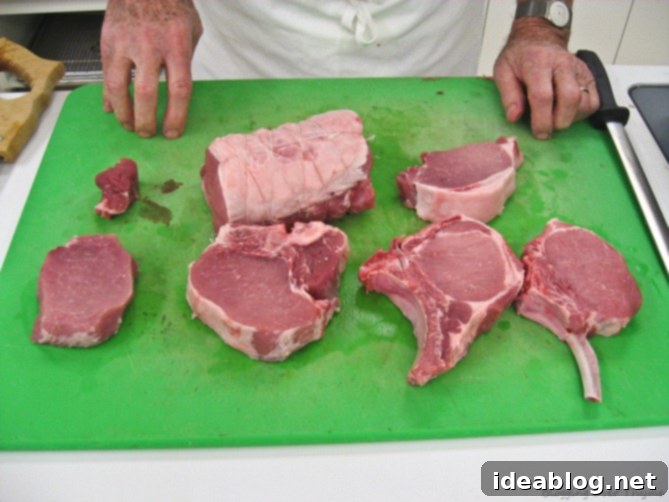
Overall, it was another productive and insightful day in the kitchen, with relatively few significant hurdles encountered. Even the seemingly mundane task of cleaning out the stock pot provided a familiar, if strenuous, “workout.” It had been a while since I last tackled this particular chore, but the muscle memory quickly returned, reminding me that every aspect of culinary school, from the glamorous to the grimy, contributes to a well-rounded chef. Such tasks reinforce discipline and the importance of a clean and organized workspace.
With the day’s practical lessons and lectures behind me, the focus now shifts back to intense studying and preparation. The upcoming practical exam demands a comprehensive understanding of every technique and recipe covered thus far. Before officially calling it a night, there’s much more to review and internalize, ensuring I am fully equipped for the challenges ahead.
Stay tuned in a few days for comprehensive updates on tomorrow’s classes, the outcomes of my second practical exam, and many more insights from this exciting culinary journey!
